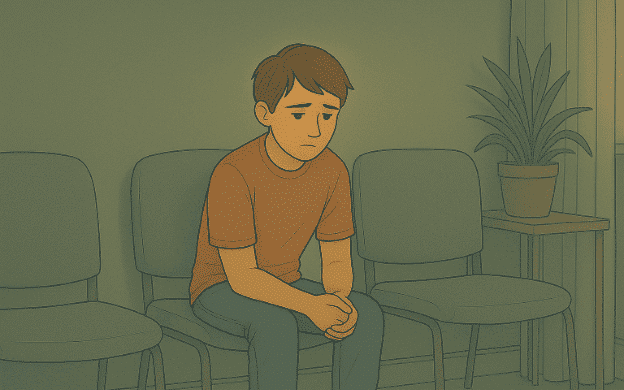Key Takeaways
- EMDR is an evidence-based therapy that helps teens process distressing experiences, reduce anxiety, and build confidence and resilience, often faster than traditional therapies.
- It targets the brain’s processing of distressing memories, addressing root causes of anxiety while easing physical and emotional symptoms.
- EMDR sessions are structured yet flexible, allowing teens to process memories safely with minimal verbal pressure and adapting to their personality and needs.
- Parents play a vital role by providing support, preparing their teen, observing progress, and reinforcing gains, while therapists guide the EMDR process.
- Mission Prep offers teen-focused EMDR in safe, supportive, and structured environments, combining personalized therapy, family involvement, and academic support to foster long-term mental wellness.
EMDR Therapy: A Promising Solution for Your Teen’s Anxiety
Eye Movement Desensitization and Reprocessing (EMDR) therapy is gaining recognition for treating anxiety in teens. Originally developed for trauma, this evidence-based approach often delivers results in fewer sessions than traditional therapies.
How EMDR Helps Anxious Teens
Unlike conventional talk therapy, EMDR targets how the brain processes distressing memories and thoughts. For anxious teens, negative beliefs like “I’m not good enough” or “I’m always in danger” can fuel anxiety. Through bilateral stimulation, usually eye movements, EMDR helps reprocess these memories, reducing their emotional impact.
Instead of only teaching anxiety management, EMDR addresses root experiences, such as bullying, academic pressure, or social rejection, helping teens feel “lighter” and easing physical symptoms like a racing heart, stomach issues, or sleep difficulties.
When EMDR May Be Right for Your Teen
EMDR may be beneficial if your teen:
- Struggles with persistent anxiety despite other interventions
- Experienced traumatic or distressing events linked to anxiety
- Holds negative self-beliefs that reinforce anxiety
- Finds it hard to talk about feelings in traditional therapy
- Shows physical symptoms like headaches, stomachaches, or sleep problems
While not every teen needs EMDR, it can be particularly effective when anxiety disrupts daily life or other treatments haven’t helped. Teens with generalized social, performance anxiety, and panic disorders have all responded positively.
Mission Prep Healthcare specializes in mental health treatment for teens aged 12-17, offering residential and outpatient programs for anxiety, depression, trauma, and mood disorders. Our therapies include CBT, DBT, EMDR, and TMS, tailored to each adolescent’s needs.
With a structured, supportive environment, we integrate academic support and family involvement to promote lasting recovery. Our goal is to help teens build resilience and regain confidence in their future.
What Exactly is EMDR Therapy and How Does it Work?

EMDR therapy helps teens reprocess distressing memories safely.
EMDR therapy is based on the idea that the mind can heal from psychological trauma, much like the body recovers from physical injuries. Distressing events can become “stuck” in the brain, carrying the original emotions, sensations, and beliefs, especially disruptive for developing teen brains.
During EMDR, a therapist guides your teen through a structured protocol using bilateral stimulation, such as eye movements, alternating taps, or tones. This stimulation mimics the brain’s natural processing during REM sleep, helping integrate fragmented memories and reduce their emotional impact.
The 8 Phases of EMDR Treatment
EMDR therapy follows a comprehensive eight-phase protocol that ensures thorough treatment of anxiety issues:
- History and Treatment Planning: The therapist gathers information about your teen’s anxiety and history to develop a treatment plan.
- Preparation: Your teen learns self-regulation techniques and what to expect during processing.
- Assessment: Together they identify target memories related to anxiety and the negative beliefs attached to them.
- Desensitization: Using bilateral stimulation, your teen processes the target memory until distress decreases.
- Installation: The therapist helps strengthen positive beliefs to replace the negative ones.
- Body Scan: Your teen identifies and processes any remaining physical tension.
- Closure: The therapist ensures your teen is stable at the end of each session.
- Reevaluation: Progress is assessed at the beginning of subsequent sessions.
For teens, therapists often modify these phases to be more engaging and appropriate for adolescent development. The structured nature of EMDR can be particularly appealing to teens who may be resistant to more open-ended talk therapy approaches.
How EMDR Differs From Traditional Talk Therapy
While traditional therapy relies on verbal expression and cognitive understanding, EMDR works directly with the brain’s information processing system. This makes it ideal for teens who struggle to articulate emotions or find talk therapy “boring.” Many appreciate not having to share every detail, which can help with privacy or embarrassment concerns.
Another advantage is speed: traditional therapy often takes months to show results, while EMDR can produce measurable improvements in fewer sessions, helpful for teens seeking relief or motivation.
The Science Behind EMDR for Anxiety
EMDR engages the brain’s natural processing systems. Anxiety-producing events can leave fragmented emotional memories that trigger responses. Neuroimaging shows EMDR activates the limbic system (emotions) and prefrontal cortex (rational thinking), helping teens reprocess memories while maintaining emotional control.
This dual-attention approach, focusing on distressing material with bilateral stimulation, helps integrate memories properly, allowing teens to face formerly triggering situations without overwhelming emotional or physical reactions.
EMDR’s Proven Track Record With Teen Anxiety
Evidence supporting EMDR for adolescent anxiety continues to grow. Controlled studies show it can be as effective, or more so, than traditional therapies, often achieving results in fewer sessions.
Research Results: EMDR vs. Other Treatments
Meta-analyses comparing EMDR to cognitive behavioral therapy (CBT) show comparable or superior outcomes, frequently without the homework that teens often resist.
Types of Teen Anxiety EMDR Helps Most
EMDR is particularly effective for:
- Social anxiety from peer rejection or humiliation
- Performance anxiety in academics or sports
- Specific phobias with clear triggers
- Panic attacks with identifiable causes
- Anxiety linked to adverse childhood experiences
Teens with generalized anxiety disorder also benefit, though they may need more sessions. The key is addressing memories or experiences fueling the anxiety.
What Happens During EMDR Sessions for Teens

Therapists adapt EMDR to each teen’s personality, creative, verbal, or tech-savvy approaches keep sessions engaging.
Understanding EMDR can ease both parent and teen anxiety. The process is structured but flexible, adapting to adolescents’ needs and comfort.
First Session: Assessment and Planning
Initial sessions focus on rapport and understanding your teen’s anxiety triggers. Therapists gather information about past experiences contributing to anxiety and collaborate on a treatment plan, often using timelines or guided discovery to engage teens.
The Reprocessing Experience
During processing, your teen focuses on a target memory while engaging in bilateral stimulation, typically following finger movements or using alternating buzzers. Teens don’t need to talk constantly, reducing pressure to find the “right words.” They simply notice thoughts, feelings, or sensations between stimulation sets, allowing the brain to make natural connections.
How Long Until Results Appear
Many teens show improvement after 3–6 sessions, with reduced physical anxiety, better sleep, or improved concentration. Deeper cognitive and self-concept changes often emerge within 12 sessions for straightforward cases, though complex anxiety may require longer.
Adapting EMDR for Different Teen Personalities
EMDR is highly adaptable: verbal teens may discuss more, creative teens can use art or music, tech-savvy teens might use apps, and those with attention challenges benefit from shorter, frequent sets. This flexibility makes EMDR accessible even for teens who have struggled with other therapy approaches.
How Parents Can Support Their Teen Through EMDR
Parents play a vital role in their teen’s EMDR success. While not directly involved in most sessions, your understanding and support provide a secure base for your teen between sessions.
Preparing Your Teen
- Explain EMDR in age-appropriate terms and highlight its evidence-based approach
- Set realistic expectations, including potential temporary discomfort
- Respect your teen’s privacy while remaining available for support
- Handle practical matters like transportation and scheduling to reduce stress
- Consider attending a parent session to learn ways to support your teen
Managing Temporary Symptom Increases
Some teens may show a short-term rise in anxiety as EMDR works through challenging memories. Keep communication open without pressuring them to share details. Watch for signs like irritability, sleep issues, or withdrawal, and inform the therapist. Grounding exercises taught by therapists can help your teen manage overwhelming emotions, and these temporary increases often precede breakthroughs.
Reinforcing Progress at Home
Notice and acknowledge positive changes without creating pressure. Give your teen space to practice new skills and understand that setbacks are normal. As anxiety decreases, family issues often improve naturally, though occasional parent-child sessions can help address patterns that may unintentionally reinforce anxiety.
Finding the Right EMDR Therapist for Your Teen
The therapist-client relationship is crucial for EMDR’s success, especially for teens who may be skeptical about therapy. Look for a therapist who specializes in adolescent EMDR rather than one focused mainly on adults. Teen specialists understand developmental needs and can make sessions more engaging. Ideally, the therapist should also have training in EMDR for anxiety disorders, not just trauma.
Qualifications to Look For
Ensure the therapist has completed full EMDR basic training through an EMDRIA-approved program. EMDRIA Certified therapists have done at least 50 EMDR sessions and received 20+ hours of consultation. It’s also important that they have experience with adolescent development, anxiety treatment, and trauma-informed care to ensure safety and empowerment.
Questions to Ask Before Starting
- What experience do you have with anxious teens?
- How do you adapt EMDR for adolescents?
- How are parents involved during treatment?
- How do you measure progress and decide when treatment ends?
- What is the expected frequency and duration of sessions?
- How do you manage teen resistance?
Combining EMDR With Other Anxiety Treatments
EMDR often works best as part of a comprehensive approach to teen anxiety. Many teens benefit from combining it with other interventions specific to their individual needs.
EMDR and Medication
EMDR can be safely used alongside anxiety medication, often providing optimal relief. Medication helps manage symptoms while EMDR targets root causes, sometimes allowing for gradual dose reduction under medical supervision. If your teen is on medication, continue their regimen unless advised otherwise by their doctor, any changes should always be supervised.
Complementary Techniques
EMDR pairs well with self-management tools teens can practice between sessions. Mindfulness helps them stay present instead of fixating on worries, while rhythmic exercise like running or swimming complements EMDR’s bilateral stimulation. Good sleep habits also enhance results, supporting the brain’s processing functions.
Many therapists blend EMDR with cognitive-behavioral therapy (CBT), giving teens practical coping skills for everyday stress while EMDR addresses deeper emotional triggers. This integrated approach often delivers both short-term relief and long-lasting change.
Supporting Teens with EMDR at Mission Prep

Our licensed therapists create individualized EMDR plans to meet each teen’s unique emotional needs.
Mission Prep offers specialized mental health care exclusively for adolescents aged 12–17, providing residential, outpatient, and virtual programs specific to teen needs. Our licensed, home-like environments prioritize emotional safety, structure, and a sense of belonging, supporting teens through anxiety, depression, trauma, and related challenges.
EMDR therapy at Mission Prep is delivered by trained therapists who guide teens through structured sessions using eye movements and bilateral stimulation. This evidence-based approach helps teens process distressing memories safely, reduce emotional intensity, and build long-term coping skills. Teens benefit from minimal verbal exposure, personalized plans, and flexible in-person or telehealth options.
In addition to EMDR, Mission Prep integrates academic support, family involvement, and other evidence-based therapies like CBT and DBT. Families participate through regular communication and therapy sessions, ensuring progress continues at home. Teens experience rapid symptom relief, improved emotional regulation, and lasting resilience, all within a compassionate, supportive setting designed specifically for their developmental stage.
Frequently Asked Questions (FAQs)
Is EMDR therapy safe for teenagers?
Yes. EMDR is generally safe when conducted by trained adolescent specialists. It’s non-invasive, medication-free, and evidence-based. Temporary emotional distress can occur but resolves quickly. Therapists teach self-regulation skills and end sessions with stabilization.
How does EMDR help teens manage anxiety physically?
EMDR reduces the intensity of anxiety symptoms like racing heart, stomachaches, or sleep problems. By reprocessing triggering memories, teens experience calmer physiological responses and improved emotional regulation, supporting overall daily functioning.
Does EMDR require talking about everything that happened?
No. Teens can benefit from EMDR without fully describing traumatic experiences. The therapy relies on bilateral stimulation and brief observations, allowing the brain to process memories naturally, which eases pressure and protects privacy.
Can EMDR help with school-related anxiety?
Yes. EMDR can reduce test anxiety, performance fears, and social stress in academics. By reprocessing past triggering events, teens experience improved focus, reduced physical anxiety symptoms, and greater confidence in school settings.
Can EMDR be combined with other treatments?
Absolutely. EMDR works well alongside medications, cognitive-behavioral therapy (CBT), mindfulness, and healthy routines. Mission Prep integrates EMDR with these approaches, providing teens with personalized support to address root causes and build lasting coping skills.





















